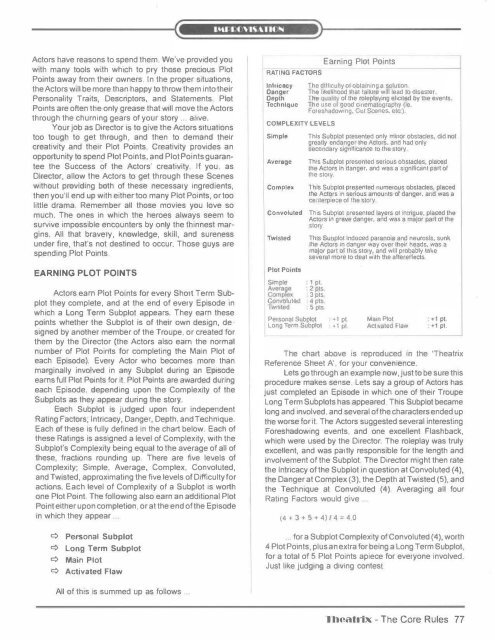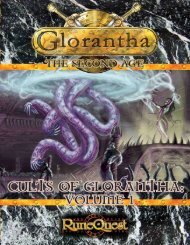Untitled - Index of - Free
Untitled - Index of - Free
Untitled - Index of - Free
You also want an ePaper? Increase the reach of your titles
YUMPU automatically turns print PDFs into web optimized ePapers that Google loves.
Actors have reasons to spend them We've provided you<br />
with many tools wtth whtch to pry those prec1ous Plot<br />
Points away from thetr owners In the proper situations.<br />
the Actors wtll be more than happy to throw them into thetr<br />
Personality Tratts, Descnptors. and Statements Plot<br />
Points are <strong>of</strong>ten the only grease that Will move the Actors<br />
through the churning gears <strong>of</strong> your story .. alive.<br />
Your JOb as Director is to give the Actors situations<br />
too tough to get through and then to demand their<br />
creativity and thetr Plot Points Creativity provides an<br />
opportunity to spend Plot Pomts. and Plot Points guaran<br />
tee the Success <strong>of</strong> the Actors' creativity If you, as<br />
Director, allow the Actors to get through these Scenes<br />
without providing both <strong>of</strong> these necessary ingredients,<br />
then you'll end up with either too many Plot Points, or too<br />
little drama Remember all those movies you love so<br />
much. The ones In which the heroes always seem to<br />
survive impossible encounters by only the thinnest mar<br />
gins. All that bravery, knowledge, skill, and sureness<br />
under fire, that's not destined to occur. Those guys are<br />
spending Plot Potnts<br />
EARNING PLOT POINTS<br />
Actors eam Plot Potnts for every Short Term Sub<br />
plot they complete, and at the end <strong>of</strong> every Episode tn<br />
which a Long Term Subplot appears. They eam these<br />
pomts whether the Subplot 1s <strong>of</strong> thetr own design, de<br />
signed by another member <strong>of</strong> the Troupe, or created for<br />
them by the Director (the Actors also earn the normal<br />
number <strong>of</strong> Plot Pomts for completing the Main Plot <strong>of</strong><br />
each Episode). Every Actor who becomes more than<br />
marginally involved in any Subplot during an Episode<br />
eams full Plot Points for it. Plot Points are awarded during<br />
each Episode, depending upon the Complexity <strong>of</strong> the<br />
Subplots as they appear during the story.<br />
Each Subplot 1s judged upon four independent<br />
Rating Factors, Intricacy, Danger, Depth. and Technique.<br />
Each <strong>of</strong> these is fully defined in the chart below. Each <strong>of</strong><br />
these Rattngs is asstgned a level <strong>of</strong> Complexity, with the<br />
Subplot's Complexity be1ng equal to the average <strong>of</strong> all <strong>of</strong><br />
these, fractions rounding up There are five levels <strong>of</strong><br />
Complextty; Simple. Average. Complex. Convoluted,<br />
and Tw1sted, approxtmattng the five levels <strong>of</strong> Difficulty for<br />
actions. Each level <strong>of</strong> Complexity <strong>of</strong> a Subplot is worth<br />
one Plot Potnt The followtng also earn an addit1onal Plot<br />
Point either upon completion or at the end <strong>of</strong> the Episode<br />
in which they appear<br />
¢ Personal Subplot<br />
¢ long Term Subplot<br />
¢ Main Plot<br />
¢ Activated Flaw<br />
All <strong>of</strong> th1s Is summed up as follows ...<br />
I<br />
RATING FACTORS<br />
Intricacy<br />
Danger<br />
Depth<br />
Technique<br />
COMPLEXITY LEVELS<br />
Simple<br />
Average<br />
Complex<br />
Convoluted<br />
Twisted<br />
Plot Points<br />
Simple : 1 pt<br />
Avera g e • 2 pts<br />
Complex • 3 pts<br />
Convolut9d • 4 pts<br />
Twisted 5 pts<br />
Earning Plot Points<br />
---- -- --i<br />
The dtlhculty ot obtamlng a solution<br />
The likelihood that failure will lead to disasLer<br />
The quality <strong>of</strong> the roleplaying ellcrted by the events<br />
The use ol good cmematography (ie<br />
Foreshadow•ng. Cut Scenes. etc.)<br />
This Subplot presented only minor obstacles, did not<br />
greatly endanger the Actors. and had only<br />
secondary signillcance to the story<br />
This Subplot presented serious obstacles, placed<br />
the Actors in danger. and was a significant part <strong>of</strong><br />
the story<br />
1 his Subplot presented numerous obstacles, placed<br />
the Actors tn serious amounts <strong>of</strong> danger, and was a<br />
centerpiece <strong>of</strong> the story<br />
Thts Subplot presented layers <strong>of</strong>lntngue, placed the<br />
Actors ill grave danger, and was a major part ot the<br />
story<br />
This Subplot Induced paranoia and neurosis, sunk<br />
the Actors In danger way over their heads, was a<br />
major part <strong>of</strong>lhis story, and will probably take<br />
several more to deal With the aftereffects<br />
Personal Subplot : + I pt<br />
long Term Subplot : • 1 pi<br />
Mam Plot<br />
Activated Flaw<br />
+1 pt.<br />
+1 pl.<br />
The chart above rs reproduced In the 'Theatrix<br />
Reference Sheet A , for your convenience.<br />
lets go through an example now, just to be sure this<br />
procedure makes sense lets say a group <strong>of</strong> Actors has<br />
just completed an Episode in which one <strong>of</strong> their Troupe<br />
long Term Subplots has appeared This Subplot became<br />
long and involved, and several <strong>of</strong> the characters ended up<br />
the worse for it The Actors suggested several Interesting<br />
Foreshadowtng events and one excellent Flashback,<br />
which were used by the Director The roleplay was truly<br />
excellent, and was partly responsible for the length and<br />
involvement <strong>of</strong> the Subplot The Director might then rate<br />
the lntr1cacy <strong>of</strong> the Subplot tn question at Convoluted { 4 ),<br />
the Danger at Complex (3). the Depth at Tw1sted (5), and<br />
the Techntque at Convoluted (4) Averag1ng all four<br />
Rallng Factors would gtve<br />
(4+3+5+4)/4=40<br />
for a Subplot Complexity <strong>of</strong> Convoluted ( 4 ), worth<br />
4 Plot Potnts, plus an extra for be1ng a Long Term Subplot,<br />
for a total <strong>of</strong> 5 Plot Points apiece for everyone involved.<br />
Just like judgtng a d1v1ng contest.<br />
llleaii'IX- The Core Rules 77



